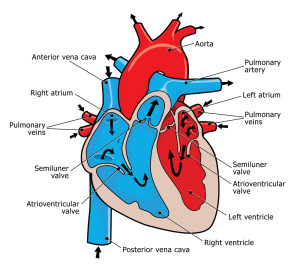Introduction
Heart disease can affect different aspects of the heart. Without a heart beat there is no life. One of the earliest signs of an intact pregnancy is a beating heart on the ultrasound monitor.
Without a beating heart the circulation stops, the brain stops and the person dies. This emphasizes how important a healthy heart is to our well being. And yet most of us never have a problem with it until very late in life.
We take note that our heart beats faster when we rush up some stairs or run in order to catch a bus. When we rest our heart, it will settle very quickly and we no longer pay attention to our heart beat.
Electrical system within the heart
The regulation of the heart beat is accomplished through a special network of nerve fibers which is connected to a small regulatory center called the ” sinus node”. This collection of nerve cells which is attached to the wall of the main vein going into the right heart chamber functions like a computer chip.
Transmission of electrical impulses starting from sinus node
Electrical signals are generated in it all the time and transmitted to the heart muscle cells allowing all the heart fibers to contract and relax at the same time. This renders the heart into a highly efficient pump moving blood from one end of the body to the other end. The sinus node has also connections to the sympathetic nervous system. With this set up the heart is able to adapt to exercise demands or to emotional states (anger, stress) with a faster heart rate and to rest periods like sleep with a decrease in heart rate. There are five major types of heart diseases, which are discussed under the links in the above table (angina, heart attacks, arrhythmia, congestive heart failure and heart valve disease).
Heart valve disease
Intact heart valves are important for proper functioning of the heart pump mechanism to propel the blood in one direction. When heart valves are insufficient, some blood regurgitates and the pump mechanism is insufficient leading to congestive heart failure. If a heart valve is stenotic, some blood stays behind and there are circulation problems. Chapters like aortic valve stenosis or mitral valve stenosis deal with this.
Hormonal factors in heart disease
Aging males with a lack of testosterone have a high risk for developing heart disease. So, with erectile dysfunction, which often is due to testosterone deficiency it is as important to look after his heart function as well as the erectile dysfunction. Often a testosterone level will confirm low testosterone and replacing the missing testosterone may fix both erectile dysfunction and prevent heart trouble. In women after menopause too little estradiol and progesterone can also cause heart disease. Bioidentical hormone replacement in women will solve the symptoms of menopause and prevent heart troubles.
References
1. The Merck Manual, 7th edition, by M. H. Beers et al., Whitehouse Station, N.J., 1999. Chapters 197, 202, 205 and 207.
2. Braunwald: Heart Disease: A Textbook of Cardiovascular Medicine, 6th ed., 2001, W. B. Saunders Co.
3. D C Bauer: Audio-Digest Family Practice Vol. 49, Iss. 09, March 2, 2001.
4. Ferri: Ferri’s Clinical Advisor: Instant Diagnosis and Treatment, 2004 ed., Copyright © 2004 Mosby, Inc.
5. Rakel: Conn’s Current Therapy 2004, 56th ed., Copyright © 2004 Elsevier







